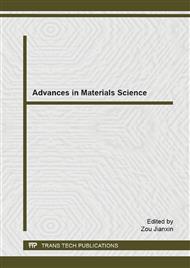[1]
J J Eggleston, G B Mcfadden and P W Voorhees: A phase-field model for highly anisotropic interfacial energy[J]. Physica D, 2001, 150(1/2): 91-103.
DOI: 10.1016/s0167-2789(00)00222-0
Google Scholar
[2]
H Kasajima, E Nagano, T Suzuki, S G Kim and W T Kim: Phase-field modeling for facet dendrite growth of silicon[J]. Sci Technol Adv Mater, 2003, 4(6): 553- 557.
DOI: 10.1016/j.stam.2003.09.017
Google Scholar
[3]
G W Zhang, H Hou and J Cheng: Phase field model for strong anisotropy of kinetic and highly anisotropic interfacial energy[J]. Trans Nonferrous Met Soc China, 2006, 16(s2): s307-s313.
Google Scholar
[4]
G W Zhang, H Hou, Y H Zhao and J Cheng: Phase-field model for highly anisotropic interfacial energy in crystal growth[J]. Foundry Technology, 2008, 29(2): 239-243.
Google Scholar
[5]
Z Chen, C L Chen and L M Hao: Numerical simulation of facet dendritic growth in a forced flow[J]. Can J Phys, 2009, 87(2): 117-123.
DOI: 10.1139/p08-124
Google Scholar
[6]
Z Chen, L M Hao and C L Chen: Simulation of faceted dendrite growth of non-isothermal alloy in forced flow by phase field method [J]. J Cent South Univ Technol, 2011, 18(6): 1780-1788.
DOI: 10.1007/s11771-011-0902-4
Google Scholar
[7]
R Z Xiao, Z P Wang, C S Zhu, W S Li and L Feng: Influence of anisotropy on dendritic growth in binary alloy with phase-field simulation[J]. ISIJ International, 2009, 49(8): 1156-1160.
DOI: 10.2355/isijinternational.49.1156
Google Scholar
[8]
X F Yuan and Y T Ding: Phase-field simulation of dendrite growth process for binary Ni-Cu alloy with anisotropy of strong interface energy[J]. The Chinese Journal of Nonferrous Metal, 2011, 21(7): 1656 -1663.
Google Scholar
[9]
X F Yuan and Y T Ding: Phasefield simulation of dendrite growth for binary alloy with strong anisotropy[J]. The Chinese Journal of Nonferrous Metal, 2011, 21(9): 2216-2222.
Google Scholar
[10]
T Suzuki, S G Kim and W T Kim: Two-dimensional facet crystal growth of silicon from undercooled melt of Si-Ni alloy[J]. Mater Sci Eng A, 2007, 449: 99-104.
DOI: 10.1016/j.msea.2006.02.360
Google Scholar
[11]
X F Yuan, B Y Liu, C Li, C S Zhou and Y T Ding: Phase field model for strong interfacial energy anisotropy of HCP materials[J]. Trans. Nonferrous Met. Soc. China, 2014, 24(9): 2911-2919.
DOI: 10.1016/s1003-6326(14)63426-9
Google Scholar
[12]
R Tonhardt and G Amberg: Phase-field simulation of dendritic growth in a shear flow[J]. J Cryst Growth, 1998, 194(3/4): 406- 425.
DOI: 10.1016/s0022-0248(98)00687-3
Google Scholar


